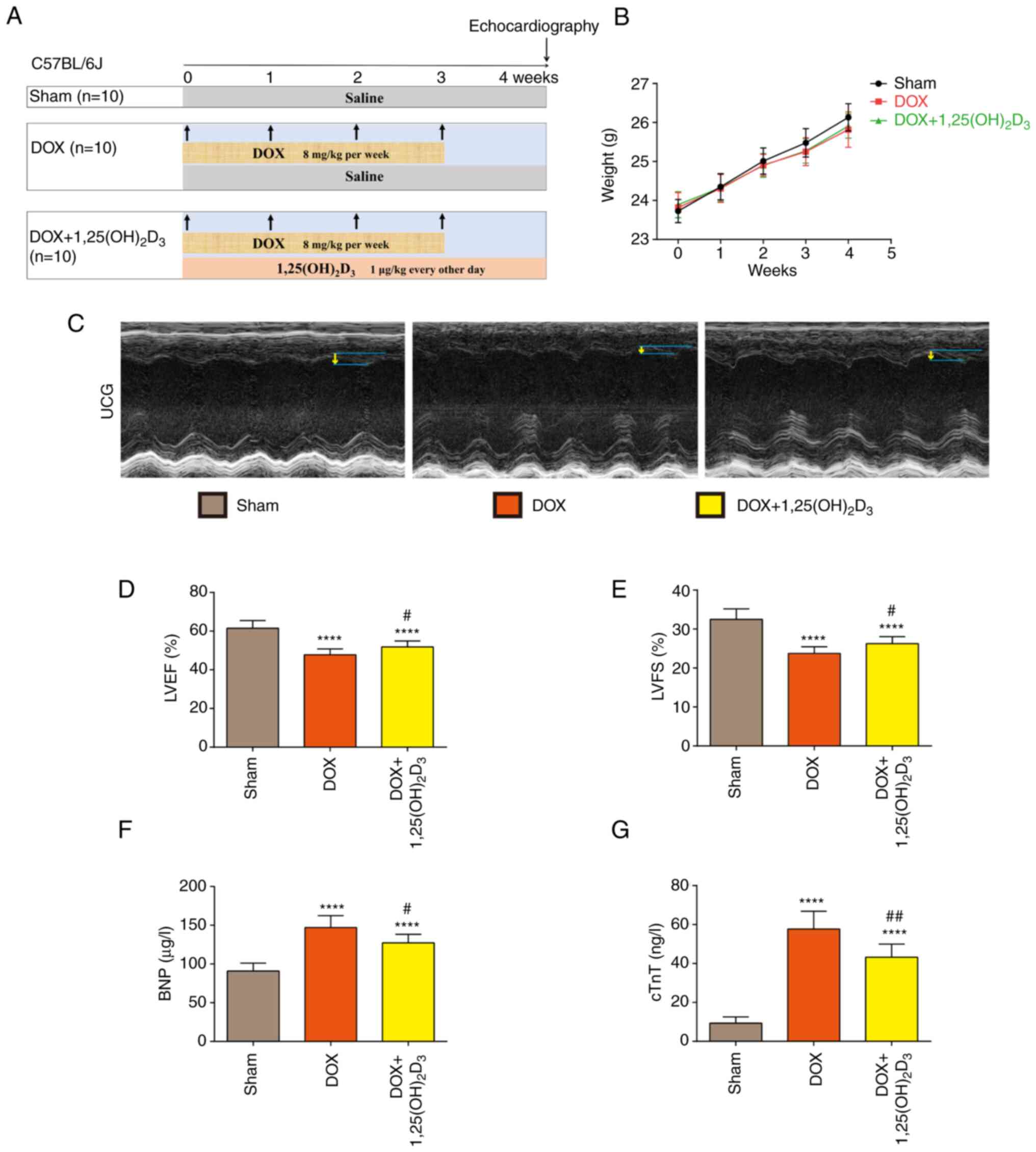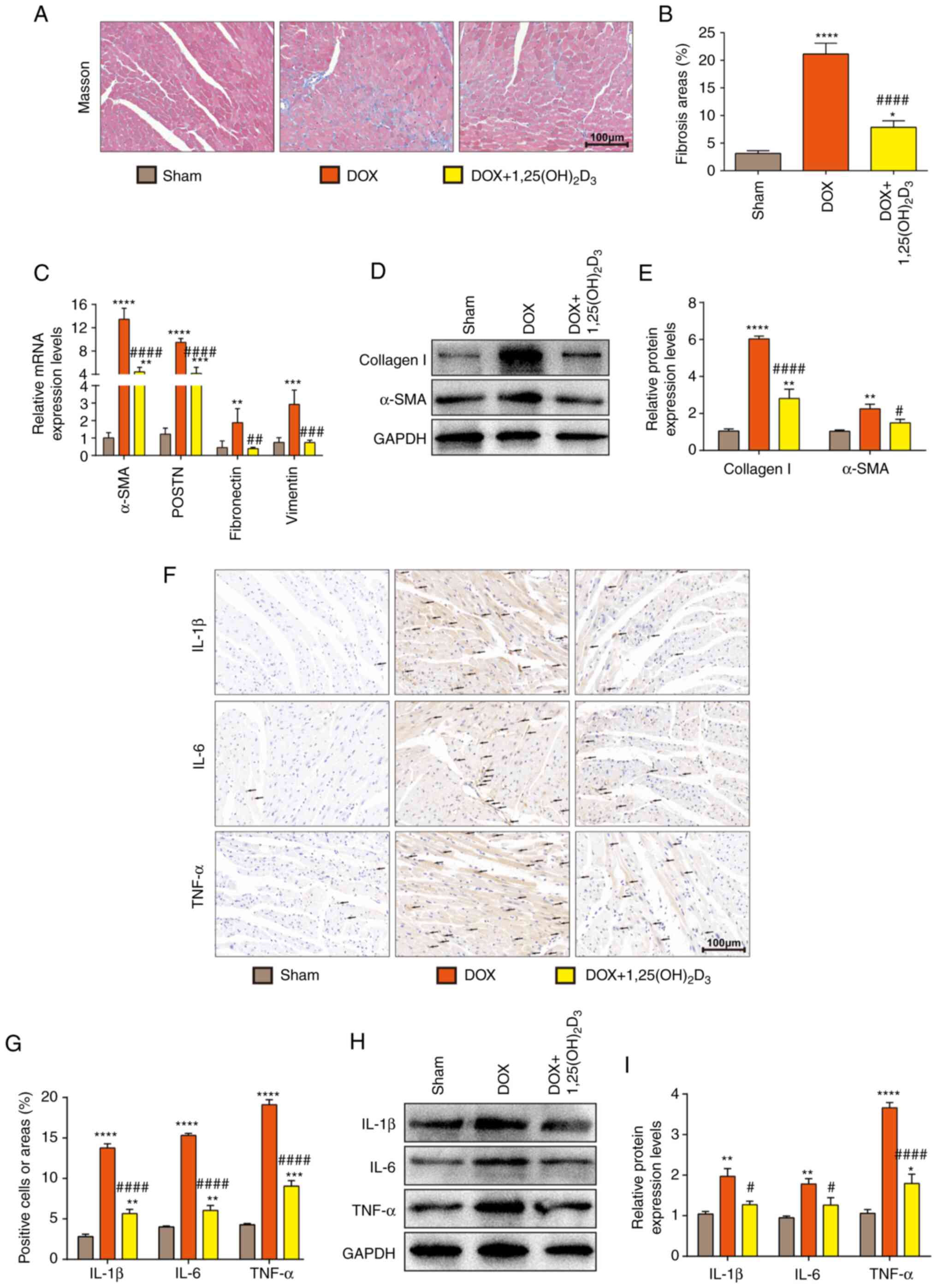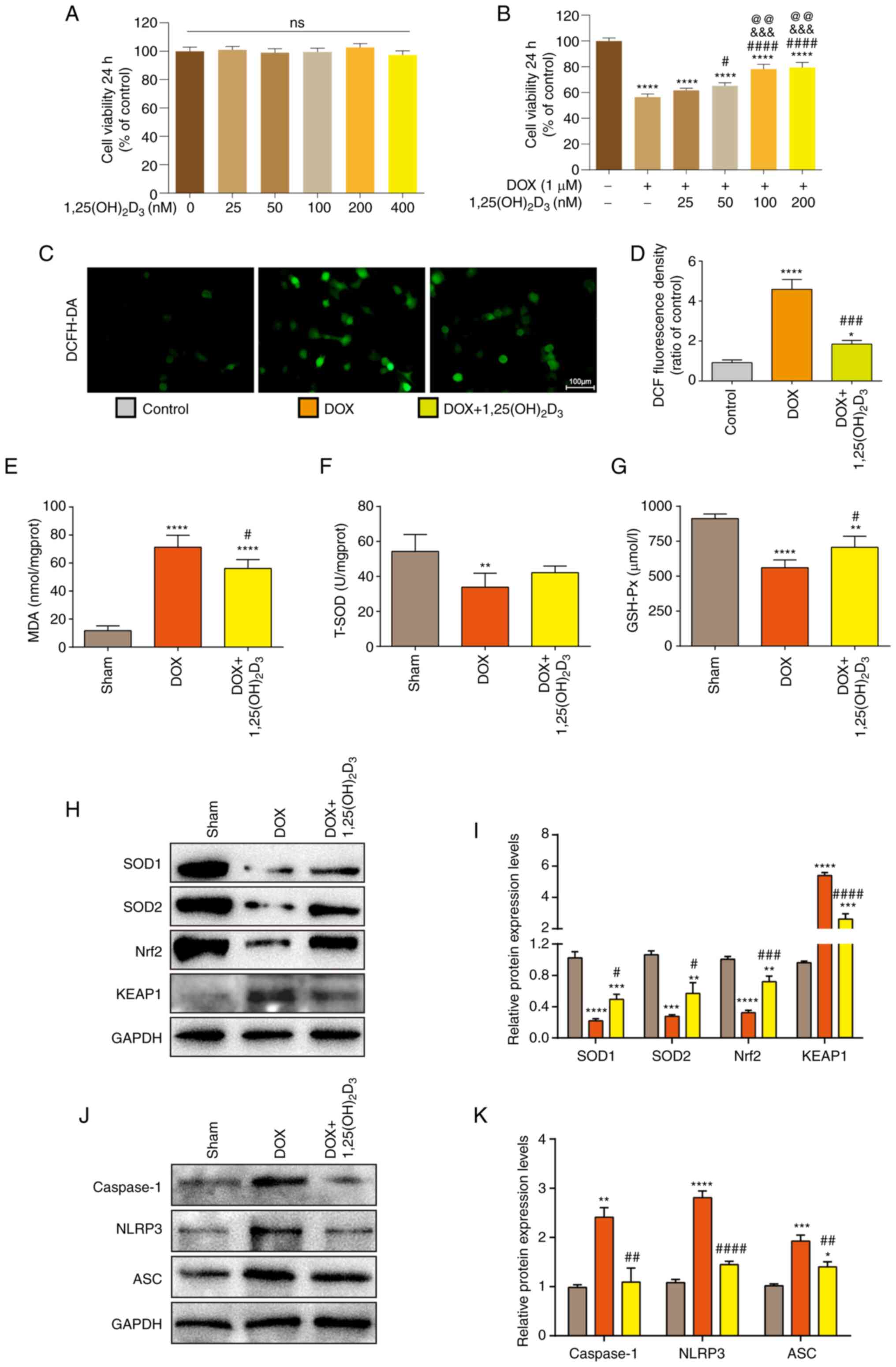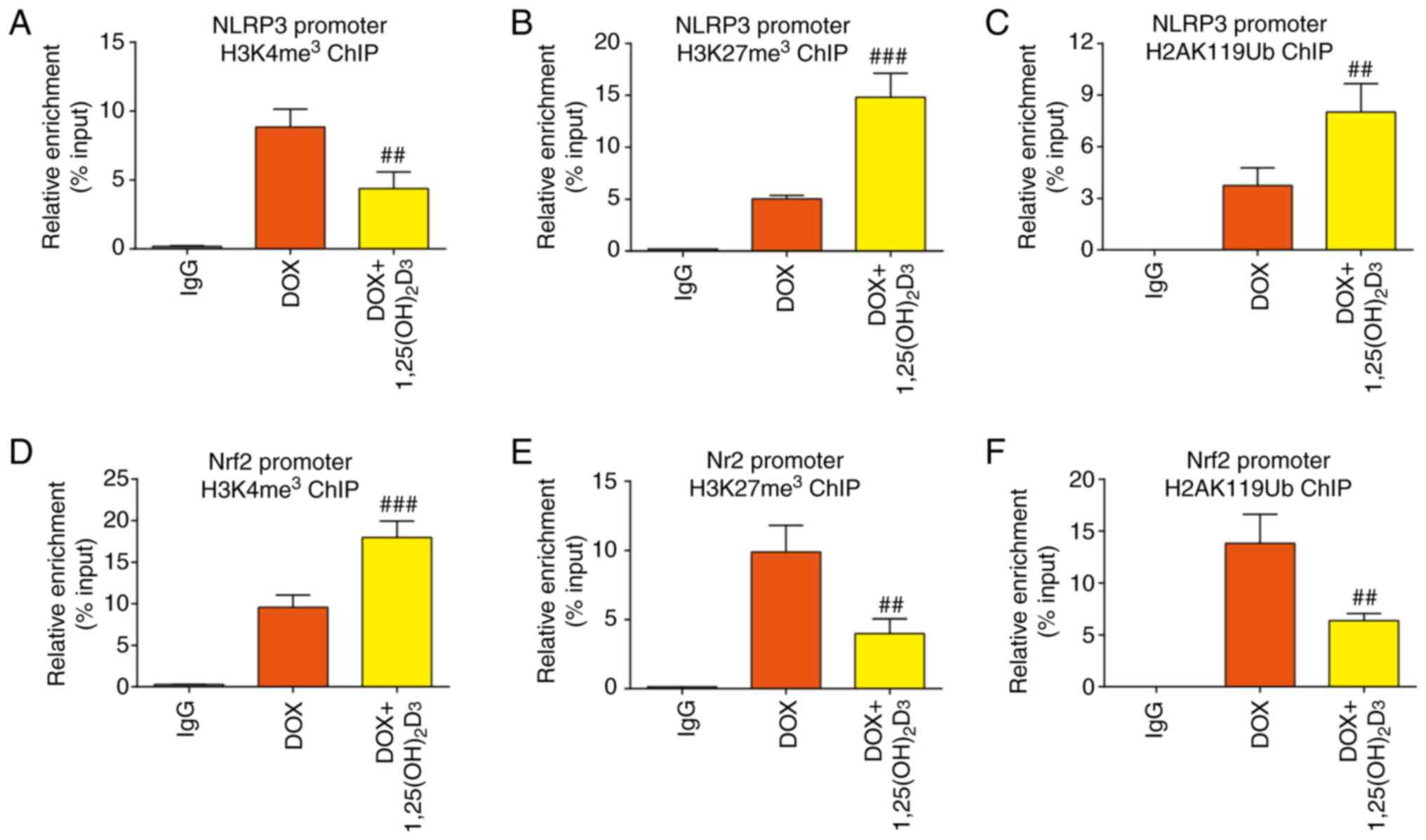|
1
|
Wang AJ, Tang Y, Zhang J, Wang BJ, Xiao M,
Lu G, Li J, Liu Q, Guo Y and Gu J: Cardiac SIRT1 ameliorates
doxorubicin-induced cardiotoxicity by targeting sestrin 2. Redox
Biol. 52(102310)2022.PubMed/NCBI View Article : Google Scholar
|
|
2
|
Kabir S, Lingappa N and Mayrovitz H:
Potential therapeutic treatments for doxorubicin-induced
cardiomyopathy. Cureus. 14(e21154)2022.PubMed/NCBI View Article : Google Scholar
|
|
3
|
Schirone L, D'Ambrosio L, Forte M,
Genovese R, Schiavon S, Spinosa G, Iacovone G, Valenti V, Frati G
and Sciarretta S: Mitochondria and doxorubicin-induced
cardiomyopathy: A complex interplay. Cells. 11(2000)2022.PubMed/NCBI View Article : Google Scholar
|
|
4
|
Baker LH, Boonstra PS, Reinke DK, Antalis
E, Zebrack BJ and Weinberg RL: Burden of chronic diseases among
sarcoma survivors treated with anthracycline chemotherapy: Results
from an observational study. J Cancer Metastasis Treat.
6(24)2020.PubMed/NCBI View Article : Google Scholar
|
|
5
|
Suzuki K, Murtuza B, Suzuki N, Smolenski
RT and Yacoub MH: Intracoronary infusion of skeletal myoblasts
improves cardiac function in doxorubicin-induced heart failure.
Circulation. 104:I213–I217. 2001.PubMed/NCBI View Article : Google Scholar
|
|
6
|
Deng S, Kulle B, Hosseini M, Schluter G,
Hasenfuss G, Wojnowski L and Schmidt A: Dystrophin-deficiency
increases the susceptibility to doxorubicin-induced cardiotoxicity.
Eur J Heart Fail. 9:986–994. 2007.PubMed/NCBI View Article : Google Scholar
|
|
7
|
Chen Y, Shi S and Dai Y: Research progress
of therapeutic drugs for doxorubicin-induced cardiomyopathy. Biomed
Pharmacother. 156(113903)2022.PubMed/NCBI View Article : Google Scholar
|
|
8
|
Christakos S, Dhawan P, Verstuyf A,
Verlinden L and Carmeliet G: Vitamin D: Metabolism, molecular
mechanism of action, and pleiotropic effects. Physiol Rev.
96:365–408. 2016.PubMed/NCBI View Article : Google Scholar
|
|
9
|
Carlberg C and Munoz A: An update on
vitamin D signaling and cancer. Semin Cancer Biol. 79:217–230.
2022.PubMed/NCBI View Article : Google Scholar
|
|
10
|
Malluche HH, Henry H, Meyer-Sabellak W,
Sherman D, Massry SG and Norman AW: Effects and interactions of
24R,25(OH)2D3 and 1,25(OH)2D3 on bone. Am J Physiol. 238:E494–E498.
1980.PubMed/NCBI View Article : Google Scholar
|
|
11
|
Carlberg C: Vitamin D signaling in the
context of innate immunity: Focus on human monocytes. Front
Immunol. 10(2211)2019.PubMed/NCBI View Article : Google Scholar
|
|
12
|
Chanakul A, Zhang MY, Louw A, Armbrecht
HJ, Miller WL, Portale AA and Perwad F: FGF-23 regulates CYP27B1
transcription in the kidney and in extra-renal tissues. PLoS One.
8(e72816)2013.PubMed/NCBI View Article : Google Scholar
|
|
13
|
Ismailova A and White JH: Vitamin D,
infections and immunity. Rev Endocr Metab Disord. 23:265–277.
2022.PubMed/NCBI View Article : Google Scholar
|
|
14
|
de la Guia-Galipienso F, Martinez-Ferran
M, Vallecillo N, Lavie CJ, Sanchis-Gomar F and Pareja-Galeano H:
Vitamin D and cardiovascular health. Clin Nutr. 40:2946–2957.
2021.PubMed/NCBI View Article : Google Scholar
|
|
15
|
Guo X, Lin H, Liu J, Wang D, Li D, Jiang
C, Tang Y, Wang J, Zhang T, Li Y, et al: 1,25-Dihydroxyvitamin D
attenuates diabetic cardiac autophagy and damage by vitamin D
receptor-mediated suppression of FoxO1 translocation. J Nutr
Biochem. 80(108380)2020.PubMed/NCBI View Article : Google Scholar
|
|
16
|
Samefors M, Scragg R, Lanne T, Nyström FH
and Östgren CJ: Association between serum 25(OH)D3 and
cardiovascular morbidity and mortality in people with type 2
diabetes: A community-based cohort study. Diabet Med. 34:372–379.
2017.PubMed/NCBI View Article : Google Scholar
|
|
17
|
Cui C, Xu P, Li G, Qiao Y, Han W, Geng C,
Liao D, Yang M, Chen D and Jiang P: Vitamin D receptor activation
regulates microglia polarization and oxidative stress in
spontaneously hypertensive rats and angiotensin II-exposed
microglial cells: Role of renin-angiotensin system. Redox Biol.
26(101295)2019.PubMed/NCBI View Article : Google Scholar
|
|
18
|
Chen L, Yang R, Qiao W, Zhang W, Chen J,
Mao L, Goltzman D and Miao D: 1,25-Dihydroxyvitamin D exerts an
antiaging role by activation of Nrf2-antioxidant signaling and
inactivation of p16/p53-senescence signaling. Aging Cell.
18(e12951)2019.PubMed/NCBI View Article : Google Scholar
|
|
19
|
Qin Q, Liu H, Shou J, Jiang Y, Yu H and
Wang X: The inhibitor effect of RKIP on inflammasome activation and
inflammasome-dependent diseases. Cell Mol Immunol. 18:992–1004.
2021.PubMed/NCBI View Article : Google Scholar
|
|
20
|
Sharma BR and Kanneganti TD: NLRP3
inflammasome in cancer and metabolic diseases. Nat Immunol.
22:550–559. 2021.PubMed/NCBI View Article : Google Scholar
|
|
21
|
Zhang X, Hu C, Kong CY, Song P, Wu HM, Xu
SC, Yuan YP, Deng W, Ma ZG and Tang QZ: FNDC5 alleviates oxidative
stress and cardiomyocyte apoptosis in doxorubicin-induced
cardiotoxicity via activating AKT. Cell Death Differ. 27:540–555.
2020.PubMed/NCBI View Article : Google Scholar
|
|
22
|
Nolfi-Donegan D, Braganza A and Shiva S:
Mitochondrial electron transport chain: Oxidative phosphorylation,
oxidant production, and methods of measurement. Redox Biol.
37(101674)2020.PubMed/NCBI View Article : Google Scholar
|
|
23
|
Byrne NJ, Rajasekaran NS, Abel ED and
Bugger H: Therapeutic potential of targeting oxidative stress in
diabetic cardiomyopathy. Free Radic Biol Med. 169:317–342.
2021.PubMed/NCBI View Article : Google Scholar
|
|
24
|
Yang R, Zhang J, Li J, Qin R, Chen J, Wang
R, Goltzman D and Miao D: Inhibition of Nrf2 degradation alleviates
age-related osteoporosis induced by 1,25-Dihydroxyvitamin D
deficiency. Free Radic Biol Med. 178:246–261. 2022.PubMed/NCBI View Article : Google Scholar
|
|
25
|
Bosworth CR, Levin G, Robinson-Cohen C,
Hoofnagle AN, Ruzinski J, Young B, Schwartz SM, Himmelfarb J,
Kestenbaum B and de Boer IH: The serum 24,25-dihydroxyvitamin D
concentration, a marker of vitamin D catabolism, is reduced in
chronic kidney disease. Kidney Int. 82:693–700. 2012.PubMed/NCBI View Article : Google Scholar
|
|
26
|
Zhang W, Chen L, Zhang L, Xiao M, Ding J,
Goltzman D and Miao D: Administration of exogenous 1,25(OH)2D3
normalizes overactivation of the central renin-angiotensin system
in 1alpha (OH)ase knockout mice. Neurosci Lett. 588:184–189.
2015.PubMed/NCBI View Article : Google Scholar
|
|
27
|
Yang R, Chen J, Zhang J, Qin R, Wang R,
Qiu Y, Mao Z, Goltzman D and Miao D: 1,25-Dihydroxyvitamin D
protects against age-related osteoporosis by a novel VDR-Ezh2-p16
signal axis. Aging Cell. 19(e13095)2020.PubMed/NCBI View Article : Google Scholar
|
|
28
|
Tomczyk MM, Cheung KG, Xiang B, Tamanna N,
Fonseca TA, Agarwal P, Kereliuk SM, Spicer V, Lin L, Treberg J, et
al: Mitochondrial sirtuin-3 (SIRT3) prevents doxorubicin-induced
dilated cardiomyopathy by modulating protein acetylation and
oxidative stress. Circ Heart Fail. 15(e8547)2022.PubMed/NCBI View Article : Google Scholar
|
|
29
|
Gu X, Gu B, Lv X, Yu Z, Wang R, Zhou X,
Qiao W, Mao Z, Zuo G, Li Q, et al: 1, 25-dihydroxy-vitamin D3 with
tumor necrosis factor-alpha protects against rheumatoid arthritis
by promoting p53 acetylation-mediated apoptosis via Sirt1 in
synoviocytes. Cell Death Dis. 7(e2423)2016.PubMed/NCBI View Article : Google Scholar
|
|
30
|
Schindelin J, Arganda-Carreras I, Frise E,
Kaynig V, Longair M, Pietzsch T, Preibisch S, Rueden C, Saalfeld S,
Schmid B, et al: Fiji: An open-source platform for biological-image
analysis. Nat Methods. 9:676–682. 2012.PubMed/NCBI View Article : Google Scholar
|
|
31
|
Livak KJ and Schmittgen TD: Analysis of
relative gene expression data using real-time quantitative RCR and
the 2(-Delta Delta C(T)) method. Methods. 25:402–408.
2001.PubMed/NCBI View Article : Google Scholar
|
|
32
|
Chen B and Zhang JP: Bcl-xL is required
for the protective effects of low-dose berberine against
doxorubicin-induced cardiotoxicity through blocking apoptosis and
activating mitophagy-mediated ROS elimination. Phytomedicine.
101(154130)2022.PubMed/NCBI View Article : Google Scholar
|
|
33
|
Bi Y, Xu H, Wang X, Zhu H, Ge J, Ren J and
Zhang Y: FUNDC1 protects against doxorubicin-induced cardiomyocyte
PANoptosis through stabilizing mtDNA via interaction with TUFM.
Cell Death Dis. 13(1020)2022.PubMed/NCBI View Article : Google Scholar
|
|
34
|
Shi S, Chen Y, Luo Z, Nie G and Dai Y:
Role of oxidative stress and inflammation-related signaling
pathways in doxorubicin-induced cardiomyopathy. Cell Commun Signal.
21(61)2023.PubMed/NCBI View Article : Google Scholar
|
|
35
|
Coll RC, Schroder K and Pelegrin P: NLRP3
and pyroptosis blockers for treating inflammatory diseases. Trends
Pharmacol Sci. 43:653–668. 2022.PubMed/NCBI View Article : Google Scholar
|
|
36
|
Harris J and Borg NA: The multifaceted
roles of NLRP3-modulating proteins in virus infection. Front
Immunol. 13(987453)2022.PubMed/NCBI View Article : Google Scholar
|
|
37
|
Moena D, Nardocci G, Acevedo E, Lian J,
Stein G, Stein J and Montecino M: Ezh2-dependent H3K27me3
modification dynamically regulates vitamin D3-dependent epigenetic
control of CYP24A1 gene expression in osteoblastic cells. J Cell
Physiol. 235:5404–5412. 2020.PubMed/NCBI View Article : Google Scholar
|
|
38
|
Park S, Kim GW, Kwon SH and Lee JS: Broad
domains of histone H3 lysine 4 trimethylation in transcriptional
regulation and disease. FEBS J. 287:2891–2902. 2020.PubMed/NCBI View Article : Google Scholar
|
|
39
|
Kang SJ and Chun T: Structural
heterogeneity of the mammalian polycomb repressor complex in immune
regulation. Exp Mol Med. 52:1004–1015. 2020.PubMed/NCBI View Article : Google Scholar
|
|
40
|
Rawat PS, Jaiswal A, Khurana A, Bhatti JS
and Navik U: Doxorubicin-induced cardiotoxicity: An update on the
molecular mechanism and novel therapeutic strategies for effective
management. Biomed Pharmacother. 139(111708)2021.PubMed/NCBI View Article : Google Scholar
|
|
41
|
Wang Y, Zhu J and DeLuca HF: Where is the
vitamin D receptor? Arch Biochem Biophys. 523:123–133.
2012.PubMed/NCBI View Article : Google Scholar
|
|
42
|
Chen L, Yang R, Qiao W, Yuan X, Wang S,
Goltzman D and Miao D: 1,25-Dihydroxy vitamin D prevents
tumorigenesis by inhibiting oxidative stress and inducing tumor
cellular senescence in mice. Int J Cancer. 143:368–382.
2018.PubMed/NCBI View Article : Google Scholar
|
|
43
|
Spasovski G: Advances in pharmacotherapy
for hyperphosphatemia in renal disease. Expert Opin Pharmacother.
16:2589–2599. 2015.PubMed/NCBI View Article : Google Scholar
|
|
44
|
Sutterwala FS, Haasken S and Cassel SL:
Mechanism of NLRP3 inflammasome activation. Ann N Y Acad Sci.
1319:82–95. 2014.PubMed/NCBI View Article : Google Scholar
|
|
45
|
Cao R, Ma Y, Li S, Shen D, Yang S, Wang X,
Cao Y, Wang Z, Wei Y, Li S, et al: 1,25(OH)(2) D(3) alleviates
DSS-induced ulcerative colitis via inhibiting NLRP3 inflammasome
activation. J Leukoc Biol. 108:283–295. 2020.PubMed/NCBI View Article : Google Scholar
|
|
46
|
Tulk SE, Liao KC, Muruve DA, Li Y, Beck PL
and MacDonald JA: Vitamin D(3) metabolites enhance the
NLRP3-dependent secretion of IL-1β from human THP-1 monocytic
cells. J Cell Biochem. 116:711–720. 2015.PubMed/NCBI View Article : Google Scholar
|
|
47
|
Poli G, Fabi C, Bellet MM, Costantini C,
Nunziangeli L, Romani L and Brancorsini S: Epigenetic mechanisms of
inflammasome regulation. Int J Mol Sci. 21(5758)2020.PubMed/NCBI View Article : Google Scholar
|
|
48
|
Dai X, Liao R, Liu C, Liu S, Huang H, Liu
J, Jin T, Guo H, Zheng Z, Xia M, et al: Epigenetic regulation of
TXNIP-mediated oxidative stress and NLRP3 inflammasome activation
contributes to SAHH inhibition-aggravated diabetic nephropathy.
Redox Biol. 45(102033)2021.PubMed/NCBI View Article : Google Scholar
|
|
49
|
Lecoeur H, Prina E, Rosazza T, Kokou K,
N'Diaye P, Aulner N, Varet H, Bussotti G, Xing Y, Milon G, et al:
Targeting macrophage histone H3 modification as a leishmania
strategy to dampen the NF-kappaB/NLRP3-mediated inflammatory
response. Cell Rep. 30:1870–1882. 2020.PubMed/NCBI View Article : Google Scholar
|
|
50
|
Lecoeur H, Rosazza T, Kokou K, Varet H,
Coppee JY, Lari A, Commere PH, Weil R, Meng G, Milon G, et al:
Leishmania amazonensis subverts the transcription factor landscape
in dendritic cells to avoid inflammasome activation and stall
maturation. Front Immunol. 11(1098)2020.PubMed/NCBI View Article : Google Scholar
|
|
51
|
Uckelmann M and Sixma TK: Histone
ubiquitination in the DNA damage response. DNA Repair (Amst).
56:92–101. 2017.PubMed/NCBI View Article : Google Scholar
|
|
52
|
Chan HL and Morey L: Emerging roles for
polycomb-group proteins in stem cells and cancer. Trends Biochem
Sci. 44:688–700. 2019.PubMed/NCBI View Article : Google Scholar
|
|
53
|
Barbour H, Daou S, Hendzel M and Affar EB:
Polycomb group-mediated histone H2A monoubiquitination in epigenome
regulation and nuclear processes. Nat Commun.
11(5947)2020.PubMed/NCBI View Article : Google Scholar
|
|
54
|
Han X, Zhu N, Wang Y and Cheng G:
1,25(OH)2D3 inhibits osteogenic differentiation through activating
beta-catenin signaling via downregulating bone morphogenetic
protein 2. Mol Med Rep. 22:5023–5032. 2020.PubMed/NCBI View Article : Google Scholar
|


















